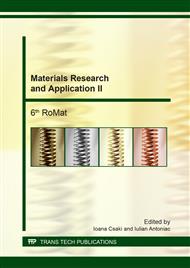[1]
G. Albertini, M. Cegielski, H. Egner, F. Fiori, A. Ganczarski, E. Girardin, A. Giuliani, S. Hernik, V. Komlev, M. Kula, A. Manescu, A. Muc. M. Oleksy, F. Rustichelli, J. Skrzypek, F. Spinozzi, Innovative Technological Materials (Structural Properties by Neutron Scattering, Synchrotron Radiation and Modeling), Editors: J.J. Skrzypek, F. Rustichelli, Springer Publ. (2010).
DOI: 10.1007/978-3-642-12059-6
Google Scholar
[2]
R. B. Knott, B. P. Schoenborn, Neutrons in Biology – A Perspective (Volume 64 of the series Basic Life Sciences, pp.1-15), Springer Publ. (1996), ISBN 978-1-4613-7680-4.
Google Scholar
[3]
http: /neutronsources. org/neutron-centres. html.
Google Scholar
[4]
http: /www. lightsources. org/regions.
Google Scholar
[5]
International Atomic Energy Agency, Measurement of Residual Stress in Materials using Neutrons, IAEA-TECDOC-1457, IAEA (2005), ISBN 92–0–106305–9; http: /www-pub. iaea. org/MTCD/Publications/PDF/te_1457_web. pdf.
DOI: 10.1259/bjr.74.879.740297
Google Scholar
[6]
M.E. Fitzpatrick, A. Lodini (eds. ), Analysis of Residual Stress by Diffraction using Neutron and Synchrotron Radiation, CRC Press (2003), ISBN 9780203608999.
DOI: 10.1201/9780203608999
Google Scholar
[7]
I.C. Noyan, J.B. Cohen, Residual Stress - Measurement by Diffraction and Interpretation, Springer Publ. (1987), ISBN: 978-1-4613-9571-3.
Google Scholar
[8]
V. Hauk, Structural and Residual Stress Analysis by Nondestructive Methods, Elsevier Publ. (1997), ISBN: 978-0d-444-82476-9.
Google Scholar
[9]
P. Fratzl, Small-angle scattering in materials science - A short review of applications in alloys, ceramics and composite materials, J Appl Cryst 36(3) (2003) 397-404.
DOI: 10.1107/s0021889803000335
Google Scholar
[10]
S. Nuzzo, F. Peyrin, P. Cloetens, J. Baruchel, G. Boivin, Quantification of the degree of mineralization of bone in three dimension using Synchrotron Radiation Microtomography. Med Phys 19 (2002) 2672-2681.
DOI: 10.1118/1.1513161
Google Scholar
[11]
M. Salomé, F. Peyrin, P. Cloetens, C. Odet, A.M. Laval-Jeantet, J. Baruchel, P. Spanne, A synchrotron radiation microtomography system for the analysis of trabecular bone samples, Med Phys 26 (1999) 2194-2204.
DOI: 10.1118/1.598736
Google Scholar
[12]
E. Maire and P.J. Withers, Quantitative X-ray tomography, Int Mat Rev 59(1) (2014) 1-43.
Google Scholar
[13]
A.J. Allen, M.T. Hutchings, C.G. Windsor, C. Andreani, Neutron diffraction methods for the study of residual stress fields, Adv Phys 34 (1985) 445-473.
DOI: 10.1080/00018738500101791
Google Scholar
[14]
H.G. Priesmeyer, J. Larsen, D. Meggers, Neutron diffraction for non-destructive strain/stress measurements in industrial devices, J Neutron Res. 2 (1994) 31-52.
DOI: 10.1080/10238169408200185
Google Scholar
[15]
G. Bruno, F. Fiori, E. Girardin, A. Giuliani, L. Koszegi, R. Levy-Tubiana, A. Manescu, F. Rustichelli, Residual stress determination in several MMC samples submitted to different operating conditions, J Neutron Res 9 (2001) 107–117.
DOI: 10.1080/10238160108200132
Google Scholar
[16]
F. Fiori, M. Marcantoni, Neutron-diffraction measurement of residual stresses in Al–Cu cold-cut welding, 74(1) (2002) s1695–s1697.
DOI: 10.1007/s003390201727
Google Scholar
[17]
L.A. Feigin, D.I. Svergun, Structure analysis by small-angle X-ray and neutron scattering, Plenum Press - New York (1987), ISBN: 978-1-4757-6626-4.
Google Scholar
[18]
O. Glatter, O. Kratky, Small-Angle X-ray Scattering, Academic Press, London (1982), ISBN 0-12-286280-5.
Google Scholar
[19]
A. Guinier, G. Fournet, Small Angle Scattering of X-ray, Wiley, New York (1955).
Google Scholar
[20]
F. Fiori, E. Girardin, G. Albertini, K. Konopka, F. Rustichelli, Small-Angle Neutron Scattering characterization of Al2O3/Ni–P nanocomposites, Mat Sci Engng B 152 (2008) 136–139.
DOI: 10.1016/j.mseb.2008.06.011
Google Scholar
[21]
G. Barucca, R. Ferragut, F. Fiori, D. Lussana, P. Mengucci, F. Moia, G. Riontino, Formation and evolution of the hardening precipitates in a Mg–Y–Nd alloy, Acta Materialia 59 (2011) 4151–4158.
DOI: 10.1016/j.actamat.2011.03.038
Google Scholar
[22]
E.N. Landis, E.N. Nagy, D.T. Keane, Microstructure and fracture in three dimensions, Eng Fract Mech 70 (2003) 911–25.
Google Scholar
[23]
S.C. Mayo, A.W. Stevenson, S.W. Wilkins, In-Line Phase-Contrast X-ray Imaging and Tomography for Materials Science, Materials 5 (2012) 937-965.
DOI: 10.3390/ma5050937
Google Scholar
[24]
International Atomic Energy Agency, Neutron Imaging: A Non-Destructive Tool for Materials Testing, IAEA-TECDOC-1604, IAEA (2008), ISBN 978–92–0–110308–6; http: /www-pub. iaea. org/MTCD/publications/PDF/te_1604_web. pdf.
DOI: 10.1259/bjr.74.879.740297
Google Scholar
[25]
J. Hohe, V. Hardenacke, V. Fascio, Y. Girard, J. Baumeister, K. Stöbener, J. Weise, D. Lehmhus, S. Pattofatto, H. Zeng, H. Zhao, V. Calbucci, F. Rustichelli, F. Fiori, Numerical and experimental design of graded cellular sandwich cores for multi-functional aerospace applications, Materials and Design 39 (2012).
DOI: 10.1016/j.matdes.2012.01.043
Google Scholar
[26]
A.T. Huber, L.J. Gibson. Anisotropy of foams. J Mater Sci 23 (1988) 3031–3040.
Google Scholar
[27]
L.J. Gibson, M.F. Ashby, Cellular Solids: Structure and Properties, Cambridge University Press (1999), ISBN 0521499119.
Google Scholar


